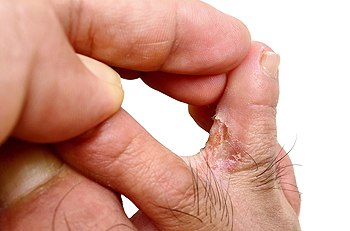
Athlete's foot, medically known as tinea pedis, is a fungal infection that affects the skin on the feet. It is causes itching, burning, and cracked, scaly skin, often occurring between the toes. The infection is caused by dermatophytes, fungi that thrive in warm, moist environments such as locker rooms, showers, and swimming pools. Athlete's foot spreads through direct contact with an infected person or by touching contaminated surfaces. Diagnosis typically involves a physical examination of the affected area by a podiatrist. In some cases, a skin scraping may be taken and examined under a microscope to confirm the presence of the fungus. Proper diagnosis is important to differentiate athlete's foot from other skin conditions. If you have any of the above symptoms, it is suggested that you consult a podiatrist who can effectively treat athlete’s foot, which may include prescribed medication.
Athlete’s Foot
Athlete’s foot is often an uncomfortable condition to experience. Thankfully, podiatrists specialize in treating athlete’s foot and offer the best treatment options. If you have any questions about athlete’s foot, consult with Dr. Larry Cohen from New York City. Our doctor will assess your condition and provide you with quality treatment.
What Is Athlete’s Foot?
Tinea pedis, more commonly known as athlete’s foot, is a non-serious and common fungal infection of the foot. Athlete’s foot is contagious and can be contracted by touching someone who has it or infected surfaces. The most common places contaminated by it are public showers, locker rooms, and swimming pools. Once contracted, it grows on feet that are left inside moist, dark, and warm shoes and socks.
Prevention
The most effective ways to prevent athlete’s foot include:
- Thoroughly washing and drying feet
- Avoid going barefoot in locker rooms and public showers
- Using shower shoes in public showers
- Wearing socks that allow the feet to breathe
- Changing socks and shoes frequently if you sweat a lot
Symptoms
Athlete’s foot initially occurs as a rash between the toes. However, if left undiagnosed, it can spread to the sides and bottom of the feet, toenails, and if touched by hand, the hands themselves. Symptoms include:
- Redness
- Burning
- Itching
- Scaly and peeling skin
Diagnosis and Treatment
Diagnosis is quick and easy. Skin samples will be taken and either viewed under a microscope or sent to a lab for testing. Sometimes, a podiatrist can diagnose it based on simply looking at it. Once confirmed, treatment options include oral and topical antifungal medications.
If you have any questions, please feel free to contact our offices located in Midtown, Manhattan New York, NY . We offer the newest diagnostic and treatment technologies for all your foot care needs.

